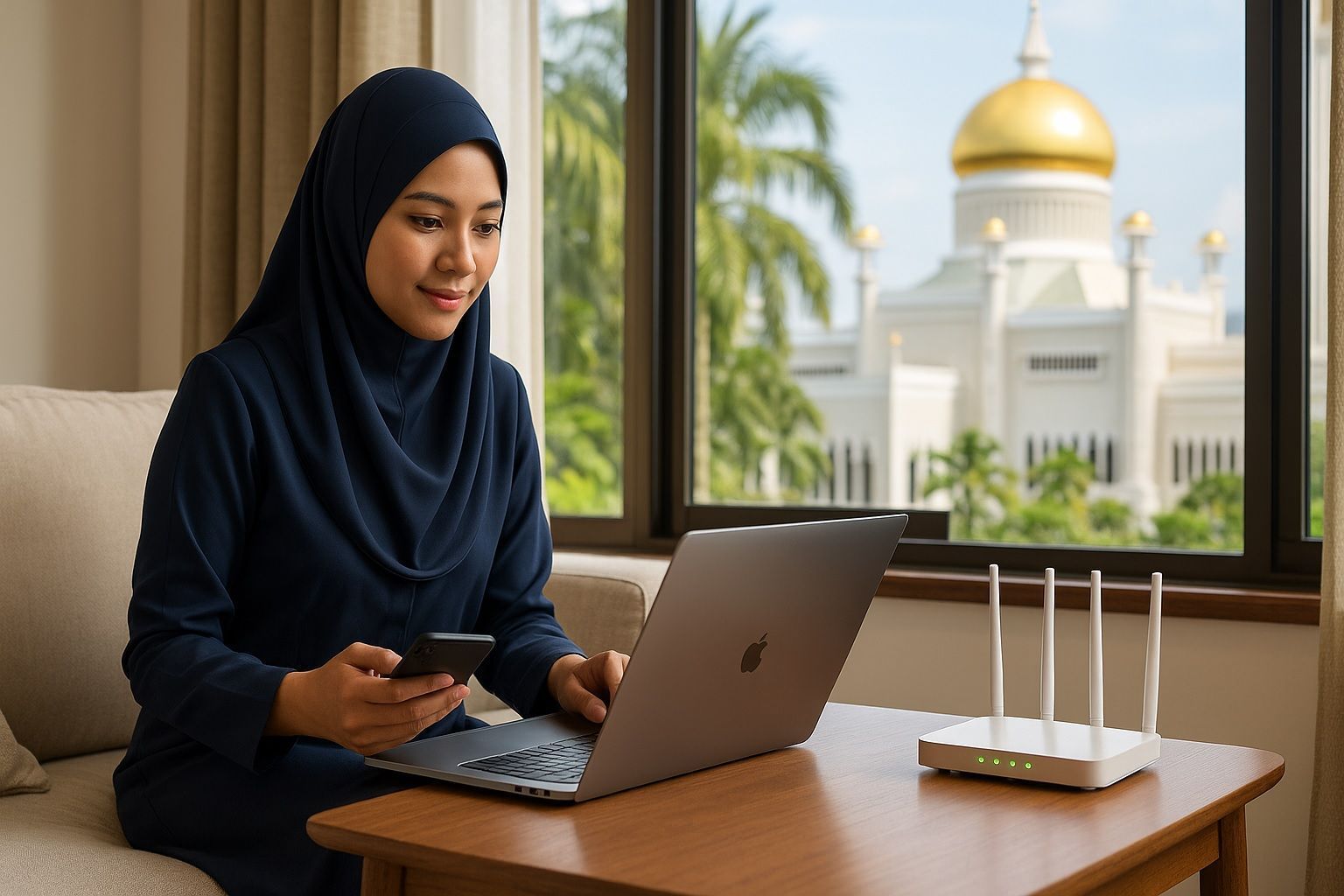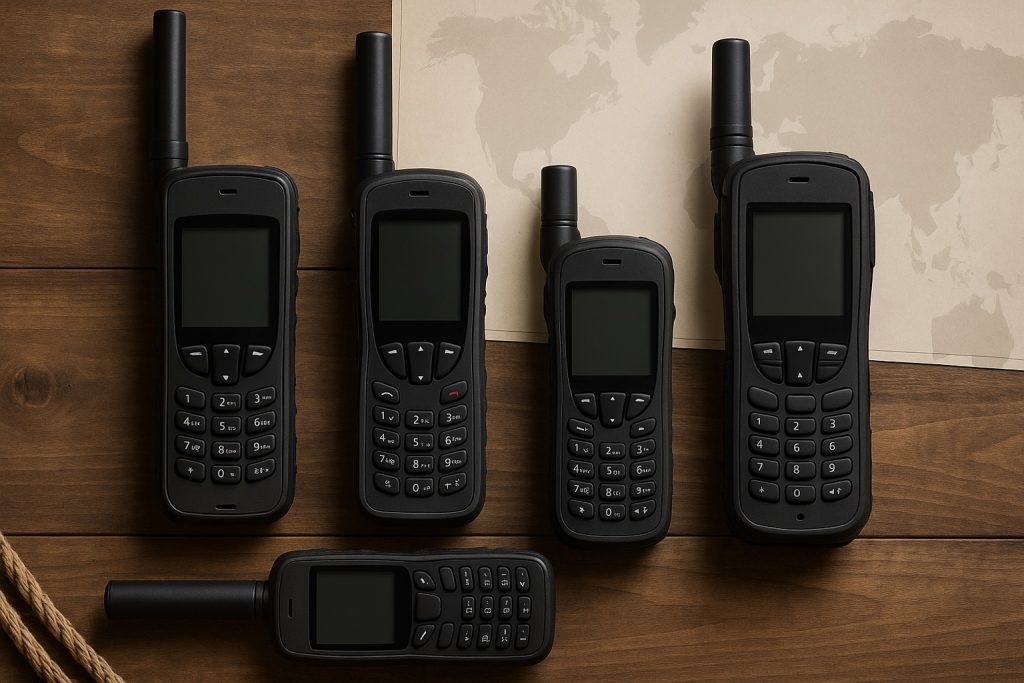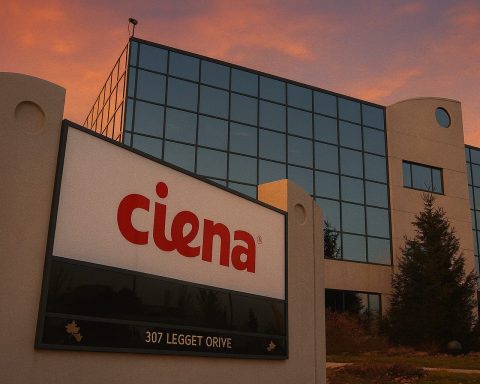- In 2019 Brunei created Unified National Networks (UNN), a wholesale network consolidating fixed, mobile, and submarine infrastructure for DST, imagine, and Progresif.
- In June 2023 Brunei officially launched nationwide 5G with about 90% of the population covered.
- A Fixed Broadband Uplift Program raised the baseline fixed broadband speed to 100 Mbps for all subscribers and tested 1 Gbps in a pilot.
- The three retail ISPs are Datastream Digital (DST), imagine, and Progresif, all reselling capacity via UNN.
- Brunei’s international connectivity is governed by three submarine cables—SEA-ME-WE3, the Asia-America Gateway (AAG), and the Southeast Asia-Japan Cable (SJC)—all under UNN.
- About 99% of Brunei’s internet traffic flows through undersea fiber cables, with NiAT providing VSAT as a backup.
- As of mid-2025 Starlink is not officially available in Brunei, pending government approval, while NiAT remains the licensed satellite gateway.
- 5G coverage now reaches about 90% of populated areas, while 4G LTE covers essentially the entire populated territory.
- Brunei’s population is about 454,000 (2024), with ~99% online and mobile penetration at ~135.9% (more subscriptions than people).
- The government’s Digital Economy Masterplan 2025 aims for a Smart Nation and a gigabit society, underpinned by the UNN-led infrastructure build.
Brunei Darussalam, a small but wealthy nation on Borneo, is undergoing an internet revolution that defies its size. With nearly 99% of its people online [1] and a nationwide rollout of 5G mobile and fiber broadband, Brunei’s digital landscape has leapt ahead in recent years. This report dives into Brunei’s surprisingly advanced internet infrastructure, the key players driving connectivity, the mix of technologies (from fiber optics to satellites) keeping everyone connected, and what the future holds – including the prospect of SpaceX’s Starlink beaming internet to remote corners of the Sultanate. Below, we explore Brunei’s internet access story, from urban centers to rural jungles, highlighting speeds, coverage, government initiatives, challenges, and upcoming trends in an engaging, easy-to-scan format.
Brunei’s Internet at a Glance
- Population: ~454,000 (2024) [2] – about 79% urban vs 21% rural [3]
- Internet penetration: ~99.0% of the population online [4] (one of the highest rates in the world)
- Mobile penetration: ~135.9% (more mobile subscriptions than people) [5] – many use multiple SIMs/devices
- Main ISPs: 3 state-linked providers – DST, imagine, Progresif [6] (all using a single wholesale network)
- Baseline fixed broadband speed:100 Mbps nationwide (up to 500 Mbps on high-end plans) [7] [8]
- Mobile network: 4G LTE everywhere; 5G launched in 2023 with ~90% population coverage [9]
- Median speeds (start of 2024): ~94.3 Mbps mobile, ~73.5 Mbps fixed [10] (huge improvements over previous years)
- International connectivity: 3 submarine cables (AAG, SJC, SEA-ME-WE3) provide ~99% of data capacity [11]; satellite plays a minor backup role
- Satellite internet:NiAT provides VSAT links for remote sites [12]; Starlink (SpaceX) is not yet available (pending government approval) [13]
- Digital goals: Smart Nation by 2025 (Digital Economy Masterplan) with ubiquitous high-speed access, moving toward a “gigabit society” [14].
This overview shows a country where virtually everyone is connected and internet speeds & coverage are rapidly catching up with global leaders. Next, we break down how Brunei achieved this – and what’s next.
The Players: Key ISPs and Infrastructure in Brunei
Brunei’s telecom sector is unique – all major telecom companies are government-owned, enabling unified development. The three retail internet service providers (ISPs) are:
- Datastream Digital (DST) – The largest telco, historically a mobile operator, now offering mobile, home broadband, and digital TV.
- imagine – Formerly the state fixed-line incumbent (TelBru), rebranded as imagine. Provides fixed fiber-to-the-home broadband and mobile services.
- Progresif – A smaller mobile operator turned full-service provider, known for innovative plans and customer-centric approach.
These three ISPs deliver services to consumers, but they don’t build their own networks anymore. In 2019, Brunei undertook a radical industry reform: Unified National Networks (UNN) was created as a wholesale network operator, consolidating all telecom infrastructure (fixed, mobile, and even submarine cables) under one roof [15]. This means DST, imagine, and Progresif all use the same national network maintained by UNN, then compete at the retail level on price and service. This shared infrastructure model prevents duplication, lowers costs, and allowed rapid upgrades in technology. “Brunei Darussalam has 3 major telecommunication providers… UNN, being a wholesale network company, looks after the country’s network infrastructure and supports the service providers” [16]. In short, the government’s consolidation of networks under UNN has let even a small market achieve economies of scale and fast rollouts of fiber and 5G.
Internationally, Brunei is connected via the Brunei International Gateway (BIG), now part of UNN [17]. UNN owns capacities in three major submarine cable systems – the SEA-ME-WE3, Asia-America Gateway (AAG), and Southeast Asia-Japan Cable (SJC) [18]. These cables link Brunei to Singapore, Hong Kong, Malaysia, and beyond, ensuring global internet connectivity. Multiple cables provide redundancy: if one fails, traffic can be rerouted through others [19]. In fact, about 99% of Brunei’s internet traffic flows through undersea fiber cables (not satellites) [20], so maintaining these links is critical.
Beyond cables, Brunei has a local satellite gateway provider (NiAT Sdn Bhd), which offers VSAT and satellite phone services for specialized needs (maritime, deep rural, emergency backup) [21] [22]. We’ll discuss NiAT and satellite internet more in a later section. Overall, the core infrastructure – from domestic fiber networks to international cables and satellites – is heavily supported by the government, ensuring even this small nation can enjoy world-class connectivity.
Types of Internet Access: Fiber, Mobile, and Satellites
Brunei’s internet is delivered through a mix of modern technologies, each serving different needs:
- Fiber-Optic Broadband: Brunei has invested heavily in fiber-to-the-home (FTTH) networks, especially in urban areas. By 2023, the telecom industry boosted “fixed broadband baseline speed for all subscribers to at least 100 Mbps” [23] – a remarkable standard that many larger countries haven’t achieved. Premium fiber plans offer up to 500 Mbps [24], and a recent pilot even tested 1 Gbps service as a proof-of-concept [25]. This fiber network upgrade (dubbed the “Fixed Broadband Uplift Program”) is part of Brunei’s push to become a Smart Nation under its Digital Economy Masterplan 2025 [26] [27]. Fiber broadband is widely available in the capital Bandar Seri Begawan and other towns, allowing fast and reliable home internet for streaming, online gaming, and business needs. Even many rural villages are being connected via fiber or high-speed DSL as the network expands.
- Mobile Broadband (4G & 5G): For the mobile-first Bruneian population, robust cellular networks ensure connectivity on the go. 4G LTE coverage has essentially reached the entire populated territory, and speeds on 4G are quite good (tens of Mbps typical). But the big leap came in June 2023, when Brunei officially launched 5G nationwide [28]. In a ceremony with all three telcos, the government announced 5G services are “activated and available nationwide” [29]. Thanks to this rollout (with technical support from Huawei and other partners [30]), about 90% of populated areas are now covered by 5G signals [31], and work continues to extend coverage. 5G allows ultra-fast mobile data – users with 5G phones can experience fiber-like speeds wirelessly (hundreds of Mbps in ideal conditions). Even 4G speeds have improved: recent data shows a median mobile download speed around 94 Mbps – nearly double the global average, and a 7.6% increase in a year [32]. Whether in the capital or smaller towns, Bruneians enjoy smooth video calls, streaming, and social media on their smartphones. Mobile broadband is truly ubiquitous, complementing the fixed fiber network.
- Satellite Internet: While fiber and cellular cover most needs, Brunei’s geography (areas of dense jungle and a separated eastern district, Temburong) means satellite communication fills some gaps. Geostationary satellites have long been used in Brunei for remote connectivity – for example, connecting isolated national park outposts, oil rigs at sea, or as backup links during submarine cable outages. Network Integrity Assurance Technologies (NiAT) is the country’s sole licensed satellite service provider [33]. NiAT offers VSAT (very small aperture terminal) services on C-band, L-band, and Ku-band satellites [34], bringing broadband to “the most remote and rural areas, deep in the jungle or on-board ships” [35]. However, traditional satellite internet is relatively costly and has higher latency, so it’s used sparingly (e.g. for enterprise or government needs) rather than by everyday consumers. The vast majority of Brunei’s populace doesn’t rely on satellite for internet – especially now that terrestrial 4G/5G covers almost all inhabited places. Still, satellites provide a critical redundancy and connectivity for truly hard-to-reach spots or emergency situations.
Telecommunications executives from Brunei’s three service providers (DST, imagine, and Progresif) join officials in launching the country’s nationwide 5G mobile network in June 2023. With over 90% of populated areas now covered by 5G [36], Brunei leapfrogged into the era of ultra-fast wireless broadband, complementing its fiber-optic infrastructure. The collaborative rollout – enabled by the unified network (UNN) and support from global tech partners – exemplifies how even a small nation can achieve cutting-edge connectivity.
Urban vs. Rural: Coverage and Availability
One of Brunei’s biggest advantages is its small size and concentrated population. Most residents live in or around the capital and a few towns – about four out of five people live in urban areas [37]. This makes it easier to provide near-universal coverage. In cities and large towns, internet access options abound: fiber broadband passes most households, and all mobile operators offer strong 4G/5G signals. Urban users can typically choose from multiple ISPs’ packages (since DST, imagine, and Progresif all resell the same fiber network, prices and customer service become key differentiators). Public WiFi hotspots are present in many commercial areas, and mobile data is affordable enough that many just tether or use cellular for home internet too.
Rural areas, which comprise only ~20% of the population [38], pose more challenge but are not left behind. Brunei’s rural regions include small villages, interior forest communities, and the Temburong district (an enclave separated from the rest of Brunei by Malaysia). To connect these areas, Brunei has extended fiber and mobile coverage as far as economically feasible. Many rural villages now have 4G coverage (and as of 2023, some even get 5G if near major routes), ensuring that residents can get online via smartphones or wireless broadband devices. For instance, Temburong – once isolated – is now connected by the Sultan Haji Omar Ali Saifuddien Bridge (since 2020) and improved telecom links; mobile towers and fiber links have greatly improved internet access in that district.
However, for very remote hamlets or deep jungle areas with only a handful of people, laying fiber or maintaining cell towers may not be practical. In such cases, satellite internet (through NiAT’s VSAT) can be deployed. NiAT’s slogan “Connecting the Unconnected” reflects its role in bridging these last gaps [39]. For example, an ecotourism lodge deep in Ulu Temburong National Park or an offshore fishing platform might use a satellite terminal to get basic internet and phone service. These are niche scenarios – again, nearly all populated villages have at least some mobile signal now.
Importantly, no significant “digital divide” exists between urban and rural in Brunei in terms of basic access. By the numbers, internet use is practically universal across communities. The government’s universal service mindset and investments through UNN mean rural folks enjoy connectivity comparable to city dwellers, albeit sometimes at lower speeds if they rely on 4G rather than fiber. As 5G coverage expands and fiber projects continue, even Brunei’s rural users are seeing performance upgrades. The nation’s small size and wealth have enabled it to achieve an enviable level of equal connectivity – something larger countries struggle with. In Brunei, whether you’re in a Bandar Seri Begawan apartment or a rainforest village, you likely can get online.
The Satellite Internet Scene: From NiAT to Starlink
While traditional satellites quietly support Brunei’s communications in the background, the buzz in 2025 is about Low Earth Orbit (LEO) satellites – especially SpaceX’s Starlink. LEO constellations promise high-speed, low-latency internet beamed from space, potentially reaching any corner of the globe without ground infrastructure. Could Starlink come to Brunei? It’s a hot topic among tech enthusiasts in the country. According to local discussions, Starlink could “bring internet to the most remote spots in Brunei by 2025, but it’s all up to the government’s approval” [40]. In other words, regulatory clearance is the main hurdle – Starlink’s satellites already cover Southeast Asia, but Brunei’s authorities must license the service before residents can legally use it.
As of mid-2025, Starlink is not yet officially available in Brunei. The government has been cautious, likely to protect local telecom providers and manage security concerns. (All ISPs are state-owned, so an outside service like Starlink operating freely could “kacau” – disturb – the status quo, as some locals note.) Other countries have faced similar deliberations – for example, India and some African nations delayed Starlink to sort out licensing, while neighbors like Philippines and Indonesia have begun approving it in certain areas. Brunei’s small size and nearly complete terrestrial coverage mean Starlink isn’t a pressing necessity for populated areas; however, it could be a game-changer for specific uses like remote education, disaster recovery, or connecting isolated border posts.
In the meantime, NiAT remains the go-to for satellite connectivity needs. NiAT can provide VSAT broadband to businesses or government agencies that need it, and also offers satellite phones for areas with no cell coverage. NiAT likely acts as the gateway if Starlink were to operate – for instance, the government might require Starlink to partner with a local entity (possibly NiAT or UNN) to manage ground stations or licenses. Another potential player is OneWeb (the British LEO satellite network) or other upcoming satellite services, though no public info has surfaced on those in Brunei.
For now, Bruneians watch and wait. Some tech-savvy individuals have speculated about trying Starlink Roam (formerly Starlink RV service) which can work in unsupported countries, but without approval such use would be unofficial. Should Brunei give the green light, Starlink kits (small dish antennas) could start popping up in kampungs and longhouses, bringing 100+ Mbps internet from the sky. This would especially benefit places currently relying on slow DSL or long-distance WiFi links. It could also provide a backup during fiber outages or when submarine cables are cut – a scenario that has caused internet slowdowns in the past (for example, a regional cable fault in 2021 affected Brunei’s speeds until repaired). In summary, satellite internet in Brunei today is a niche, specialist service via NiAT, but the coming years might see global satellite broadband becoming available to the general public, heralding a new era of competition and connectivity in the Sultanate.
Government Policies Driving Connectivity
Brunei’s remarkable internet progress did not happen by accident – it’s the result of proactive government policies and initiatives. The Sultanate’s leadership has long recognized that a robust digital infrastructure is key to economic diversification (beyond oil and gas) and improving quality of life under the national Wawasan 2035 vision. Here are some of the major policy moves and programs shaping internet access:
- Telecom Sector Restructuring (UNN Creation): Perhaps the most pivotal step was the 2019 restructuring that created Unified National Networks (UNN). The government, via its investment arm Darussalam Assets, took the bold step of consolidating all telecom network assets (fiber, mobile towers, switches, international gateways) into a single company [41]. Because “all telcos are fully government-owned”, this was easier to implement than in a privatized market [42]. Since January 2020, UNN has been leasing capacity to DST, imagine, and Progresif on a non-discriminatory basis [43]. The policy goal was to eliminate redundant infrastructure, reduce costs, and accelerate upgrades. It worked: within a few years, Brunei saw faster rollout of fiber, two rounds of broadband speed upgrades, and a coordinated 5G launch – achievements that might have taken much longer if three separate telcos were each building and competing on infrastructure. This “single wholesale network” model is relatively unique globally, and Brunei often cites it as a success in policy forums.
- National Broadband Initiatives: The government has overseen various programs to expand and improve broadband. For example, under the National Broadband Policy, targets were set for universal access and minimum speeds. The Fixed Broadband Uplift Program (run by AITI, the telecom regulator, together with UNN and telcos) is one concrete outcome – it raised the minimum home broadband speed first to 50 Mbps and now to 100 Mbps (as of mid-2023) at entry-level, with no price increase for consumers [44]. A joint statement by the industry affirmed commitment to “elevate internet experience… at affordable prices” [45]. Indeed, customers who were on 20 or 50 Mbps plans were automatically upgraded to 100 Mbps for free, reflecting a policy of “better service for same cost”. Such initiatives are aligned with Brunei’s Digital Economy Masterplan 2025, which stresses that infrastructure is a foundational “digital enabler.”
- Digital Economy Masterplan 2025: Launched in 2020 by the Digital Economy Council, this masterplan provides a roadmap to make Brunei a “Smart Nation” by 2025 [46]. Key focus areas include infrastructure, governance, industry digitalization, and human capital. On the infrastructure side, the masterplan pushes for nationwide high-speed connectivity, 5G deployment, IoT networks, and greater resiliency (e.g. more data centers and cloud services in-country). It also emphasizes digital inclusion – ensuring all citizens and businesses can participate. We see its influence in projects like community Wi-Fi, tech literacy programs, and the expansion of e-government services accessible over the internet. Essentially, the government treats internet access as a public utility and a right for citizens, heavily investing to keep Brunei at the forefront of digital development.
- Regulatory Environment: Brunei’s telecom regulator, AITI (Authority for Info-communications Technology Industry), plays a dual role – promoting growth and enforcing rules. AITI has generally favored consumer-friendly regulations, such as requiring SIM card registration (for security), monitoring service quality, and recently discussing net neutrality and fair competition frameworks [47] [48]. Because all ISPs are state-linked, overt price wars are muted, but AITI ensures tariffs remain in line with regional benchmarks (e.g., cost per Mbps in Brunei is now comparable to Singapore/Malaysia after the uplift [49]). AITI has also introduced measures to protect infrastructure – for example, harsher penalties for cable theft and vandalism, given the severe impact these have on connectivity [50] [51]. In 2021, the Penal Code was amended to impose jail and whipping for telecom cable thieves [52], underlining the government’s seriousness about safeguarding internet access.
- Public-Private Partnerships: While the government leads, it also partners with private and international players for expertise. The 5G rollout saw collaboration with Huawei and other vendors [53]. Brunei is also part of regional connectivity projects via ASEAN and the BIMP-EAGA initiative (with Malaysia, Indonesia, Philippines) to improve cross-border connectivity and share best practices. Such partnerships ensure Brunei stays updated with the latest technologies despite its small market.
In summary, Brunei’s policies treat the internet as critical infrastructure, much like roads or electricity. By centralizing investment under government guidance and setting ambitious national targets, Brunei has overcome the limitations of its size. The results speak for themselves: near-universal coverage, ever-increasing speeds, and a populace that is largely digital-savvy. Of course, maintaining this momentum comes with challenges, which we examine next.
Internet Speed, Pricing, and Usage Stats
How does Brunei’s internet actually perform, and what does it cost the average user? Thanks to recent upgrades, Brunei’s internet speeds have improved dramatically. According to Ookla’s Global Speed Index, Brunei’s fixed broadband ranked 94th worldwide in mid-2023, up from 100th a year prior [54]. The median fixed download speed was measured around 73.5 Mbps in early 2024 [55] – a 57% jump year-on-year as fiber upgrades kicked in [56]. For mobile, the median download was even higher at 94.3 Mbps [57] (remarkable for mobile, though that figure includes speedy 5G tests in the mix). In everyday terms, these speeds mean Bruneians can stream 4K videos, video-conference in HD, and download large files with ease. Even upload speeds (important for cloud applications and social media) have increased with the new network investments.
Pricing in Brunei is often considered reasonable given the high speeds, especially after the 2020–2023 reforms. All three ISPs offer similar price plans (since they use the same network, price competition is subtle). Entry-level home broadband (now 100 Mbps unlimited) costs roughly BND $59–$69 per month (around USD $45–50), which is comparable to neighboring countries’ rates for similar speeds. Higher-tier plans (300–500 Mbps) come at higher prices, but the 100 Mbps baseline at an affordable rate was a big win for consumers. The government explicitly noted that the uplift to 100 Mbps was done “at no additional cost” to existing subscribers [58]. On mobile, unlimited data plans or large data bundles are available at competitive prices (e.g., 50 GB for BND $25 in some promotions). Prepaid mobile data is also cheap, enabling nearly everyone to get online via smartphone. The high mobile subscription rate of 135% [59] indicates many people carry two SIMs or use separate plans for work and personal needs.
In terms of internet usage, Brunei’s small population translates to absolute user numbers around 450k internet users [60]. Social media is extremely popular, with about 66% of the total population active on social platforms (Facebook, Instagram, TikTok, etc.) and much higher penetration among 18–40 year olds [61]. E-commerce and online banking have healthy adoption, especially after the COVID-19 pandemic accelerated digital services. One notable metric: nearly 95% of adults have a smartphone, and many households have multiple connected devices (smart TVs, tablets, consoles). As a result, monthly data consumption is rising fast – Brunei’s ISPs report growing bandwidth demand of ~20–30% per year. The newly upgraded network capacity (and the move to 5G) is timely to handle this surge.
Another important aspect is service quality and reliability. Generally, Brunei’s internet is stable, but it’s not without occasional issues. The biggest threats to reliability have been submarine cable outages (usually due to undersea earthquakes or ships damaging cables) and local cable theft/vandalism. In late 2022, for instance, a major Asia-Pacific cable break caused slowdowns for a week until traffic rerouted. On the domestic front, AITI reported 27 cases of cable theft in 2024, causing over 8,000 hours of service outages and costing over BND $1 million in repairs [62]. These incidents, though relatively rare, remind Brunei to bolster redundancy – via backup links (like satellite or microwave) and by educating the public that cutting cables is a serious crime (punishable by heavy fines and jail [63]). The push for a “resilient network” is part of the Internet Resilience Index improvements Brunei seeks [64].
In summary, Brunei’s internet users today enjoy fast speeds at fair prices, and virtually everyone who wants access has it. There is a sense that the country has finally caught up to the world’s digital frontiers – a stark change from a decade ago when speeds were sluggish and usage lower. With informed consumers and a responsive regulatory framework, Brunei’s internet experience is slated to get even better.
Challenges and Barriers to Access
Despite the rosy picture, Brunei faces several challenges and barriers in its internet landscape. Some are common to many countries, while others are unique to Brunei’s context:
- Small Market Size: With only ~450k people, Brunei’s telecom market is tiny. This limits economies of scale – network infrastructure is expensive, and fewer customers means higher cost per user to recoup investments. This was one reason all networks were consolidated under UNN; competing networks would have been unsustainable. Even so, achieving cost-efficiency remains a challenge. The government must continuously invest (using oil revenues or state funds) to upgrade technology that in larger markets would be funded by millions of subscribers. A small market can also deter global companies from paying attention – e.g., content providers might not place caches in Brunei due to limited audience, which can cause slightly higher latency for some international content.
- Geographical Constraints: While coverage is generally great, Brunei’s terrain of thick rainforests and scattered settlements means the last 1% of connectivity can be tricky. Extending fiber to remote areas for so few users may not be economical, and maintaining cell towers in jungles (with power supply, backhaul, etc.) is challenging. The separated Temburong district was historically only reachable through Malaysia or by boat, which complicated laying fiber; a new bridge has helped, but geographic isolation still influences network design. During heavy rains or storms, infrastructure in remote areas can be hard to repair quickly. In short, the urban-rural gap in coverage, though small, persists in the most hard-to-reach locales.
- Infrastructure Vulnerabilities: As mentioned, submarine cables and terrestrial cables are critical infrastructure that can be vulnerable. Brunei relies on a handful of submarine cables – any simultaneous failure could severely disrupt internet access. While UNN has invested in redundancy (multiple cables, backup routes via Singapore or Hong Kong [65]), the threat of a major outage remains. Domestically, cable theft and vandalism have emerged as a serious problem, with incidents disrupting service for thousands [66]. The government has stiffened penalties, but preventing these incidents requires constant vigilance and public cooperation. Moreover, climate and environmental factors (lightning strikes on towers, flooding of underground cables) are ongoing challenges in maintaining network uptime.
- Keeping Pace with Tech Advances: Technology evolves rapidly – 5G today will be 6G by 2030, bandwidth demands will keep rising (think AR/VR, 8K streaming, IoT everywhere). Brunei must ensure its network infrastructure continues to scale despite the small population. This means continuous investment in upgrades like fiber-to-every-home, 5G expansion and eventual migration to next-gen mobile, more international bandwidth, and improved local data centers. Funding and executing these upgrades in a timely fashion can be difficult, especially if economic conditions fluctuate (e.g., if oil revenue dips, it could constrain telecom investment).
- Limited Competition & Innovation Pressure: With all providers owned by the state, some critics worry about complacency or lack of innovation. While the three ISPs do compete on customer service and minor plan differences, the market isn’t a free-for-all. Foreign competitors (like MyRepublic or other regional ISPs) are absent. This semi-monopoly situation can be a double-edged sword: it enables coordinated investment (good for infrastructure), but it might also slow down things like customer service improvements, creative product bundling, or aggressive price cuts that competition often spurs. The government’s challenge is to ensure the managed competition yields benefits of both cooperation and innovation – so far they’ve done okay, but it requires constant balance.
- Regulatory and Censorship Issues: Brunei has strict laws influenced by conservatism (including Sharia law elements). While the internet is mostly open, there are content controls on obscenity, gambling, and so forth. Self-censorship by ISPs or occasional blocking of sites could affect the user experience. Additionally, any new service like Starlink faces regulatory scrutiny – the process can be slow, potentially delaying beneficial technologies. Brunei needs to manage security and cultural concerns without unduly hindering internet openness and growth. Thus far, there haven’t been major reports of internet shutdowns or widespread censorship, but the legal framework exists for the government to intervene if deemed necessary. This could be seen as a barrier if, for example, certain global services were restricted in the future.
Overall, Brunei’s barriers to internet access are more about maintenance and evolution than basic availability. The country has solved the primary issue of connecting its people; now the focus is on keeping the network resilient, modern, and affordable. Continuous improvement is needed to ensure the impressive gains of the last few years are sustained in the long run.
What’s Next: Future Trends and Developments
Looking ahead, Brunei’s internet landscape is poised to continue its upward trajectory. Several exciting developments and trends are on the horizon:
- Starlink and LEO Satellites – A New Connectivity Era: By many accounts, 2025 could be the year Starlink arrives in Brunei (pending that all-important approval). If/when it does, it could spark a mini-revolution, especially for niche segments. Remote schools, rural clinics, and even regular consumers might get a new alternative broadband option literally from the sky. Starlink’s impact in other countries has been significant – for instance, in nearby Philippines, it enabled remote villages to get high-speed internet for the first time. In Brunei, Starlink could be used to augment network resilience (providing backup links if terrestrial networks go down) and ensure 100% geographical coverage. Moreover, the presence of Starlink might spur local ISPs to innovate and improve service to differentiate themselves. It’s worth noting Brunei may negotiate specific terms (e.g., requiring a local gateway or profit-sharing) before allowing Starlink. There’s also the possibility of OneWeb, Amazon’s Kuiper, or other LEO constellations eventually seeking Brunei market entry, which could further diversify options. In short, satellite internet is expected to shift from a government/enterprise tool to a mainstream consumer choice in the coming years.
- Gigabit Society Goals: Brunei is already talking about the next step after 500 Mbps home broadband. As noted in a 2023 industry statement, with the success of the 100–500 Mbps uplift and a 1 Gbps trial completed, the nation is “closer to becoming a gigabit society” [67]. We can expect gigabit fiber plans (1000 Mbps) to roll out commercially, at least in urban areas and for enterprise customers. This would put Brunei on par with Singapore and other high-tech hubs in terms of fixed broadband capability. The continued fiber network expansion (eventually replacing remaining copper lines entirely) will facilitate this. On the mobile side, while 5G is still being rolled out, the telecom community will keep an eye on 6G development globally, aiming to be ready when that standard matures (around 2030). For now, the focus is maximizing 5G usage – we may see new 5G-based services like fixed-wireless access (using 5G to deliver home internet in lieu of fiber in some areas) and IoT networks for smart city sensors, connected vehicles, and more.
- Smart Nation and Digital Services Expansion: With almost everyone online, Brunei can fully leverage e-government and digital economy initiatives. Expect more services to go digital: online citizen portals, telemedicine, remote learning programs, and support for tech startups. The government’s push for a digital economy means fostering local content and platforms too. In the next few years, Brunei might develop its own local cloud storage, strengthen its cybersecurity frameworks (to protect the burgeoning digital activity), and invest in training citizens with digital skills. Ubiquitous high-speed internet is the backbone for things like AI, fintech, e-commerce growth – areas Brunei is keen to develop as part of diversifying the economy. The high internet penetration and good speeds make the country an attractive testbed for new apps and services tailored to Malay/Borneo cultural context as well.
- Regional Connectivity and Collaboration: Brunei will likely continue partnering in regional connectivity projects. One example is exploring an alternative submarine cable route under the BIMP-EAGA initiative, which would link Brunei more directly with Sabah (Malaysia), Mindanao (Philippines) and Kalimantan (Indonesia) – reducing dependency on Singapore routes [68]. Also, with ASEAN’s goal of improving cross-border internet traffic, Brunei might benefit from closer integration of networks with its neighbors. For consumers, this could mean better roaming agreements (seamless mobile data use when crossing into Malaysia, for instance) and possibly reduced latency for regional content.
- Sustainability and Green Internet: A subtle but emerging trend is making the network more energy-efficient and environmentally friendly. Brunei’s commitment to green technologies may see solar-powered cell towers in remote areas, efficient cooling in data centers, and promotion of cloud computing (reducing the need for power-hungry local servers). With the world focusing on climate change, Brunei’s ICT sector will play its part by adopting sustainable practices in network expansion.
In conclusion, Brunei’s internet future looks bright. The country has transformed itself from lagging behind in connectivity to leading in several metrics within Southeast Asia. Challenges will continue to pop up – technological, financial, and regulatory – but if the recent past is any indication, Brunei will tackle them with a combination of government foresight, strategic partnerships, and a user-centric approach. For the ordinary Bruneian, all this boils down to one thing: faster, more accessible, and more reliable internet everywhere from the capital’s malls to the depths of the Bornean rainforest. And perhaps soon, even the sky will not be the limit, as satellites swoop in to ensure no corner of Brunei is left offline.
References
1. datareportal.com, 2. datareportal.com, 3. datareportal.com, 4. datareportal.com, 5. datareportal.com, 6. unn.com.bn, 7. thebruneian.news, 8. thebruneian.news, 9. english.news.cn, 10. datareportal.com, 11. unn.com.bn, 12. niat.com.bn, 13. www.everythingbrunei.com, 14. thebruneian.news, 15. digitalregulation.org, 16. unn.com.bn, 17. digitalregulation.org, 18. unn.com.bn, 19. unn.com.bn, 20. unn.com.bn, 21. niat.com.bn, 22. niat.com.bn, 23. thebruneian.news, 24. thebruneian.news, 25. thebruneian.news, 26. thebruneian.news, 27. thebruneian.news, 28. english.news.cn, 29. english.news.cn, 30. english.news.cn, 31. english.news.cn, 32. datareportal.com, 33. niat.com.bn, 34. niat.com.bn, 35. niat.com.bn, 36. english.news.cn, 37. datareportal.com, 38. datareportal.com, 39. niat.com.bn, 40. www.everythingbrunei.com, 41. digitalregulation.org, 42. digitalregulation.org, 43. digitalregulation.org, 44. thebruneian.news, 45. thebruneian.news, 46. thebruneian.news, 47. www.aiti.gov.bn, 48. www.aiti.gov.bn, 49. thebruneian.news, 50. aiti.gov.bn, 51. aiti.gov.bn, 52. aiti.gov.bn, 53. english.news.cn, 54. thebruneian.news, 55. datareportal.com, 56. datareportal.com, 57. datareportal.com, 58. thebruneian.news, 59. datareportal.com, 60. datareportal.com, 61. datareportal.com, 62. aiti.gov.bn, 63. aiti.gov.bn, 64. thebruneian.news, 65. unn.com.bn, 66. aiti.gov.bn, 67. thebruneian.news, 68. subtelforum.com










